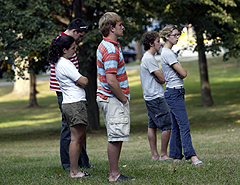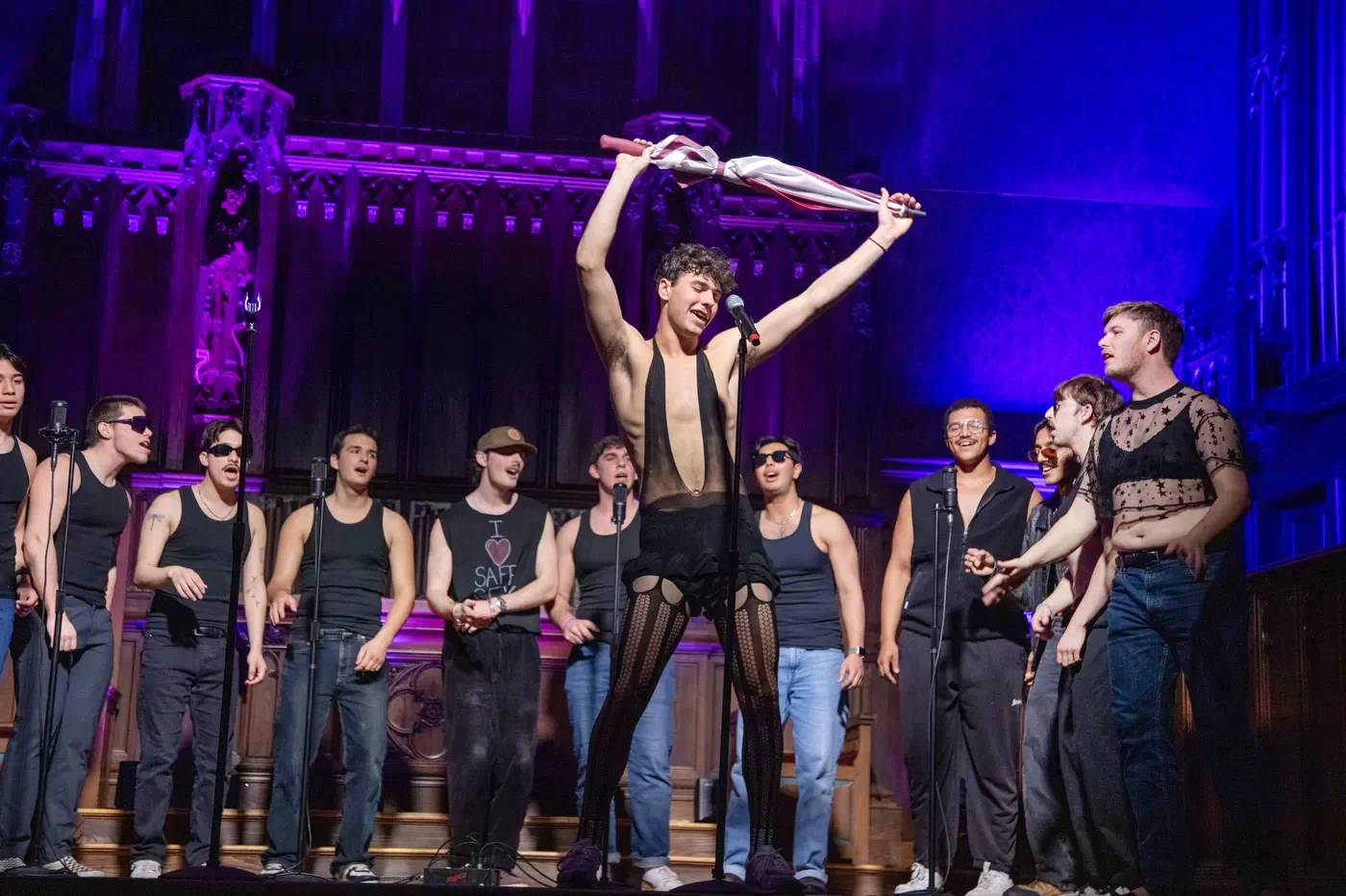'When the bells tolled, everyone stopped'
On the sunny and dreadful Tuesday that was Sept. 11, 2001, an afternoon Chapel service drew nearly 1,000 members of a Bates College community whose shock and dismay mirrored sentiments around the nation and the world.
“We come here so we don’t have to be alone in our fear,” Chaplain Kerry Maloney said that day.
On the sunny Wednesday that was Sept. 11, 2002, the campus response to that aching memory again reflected the national mood, balanced somewhere between “life goes on” and “things will never be the same.”
Sarah Rorimer, a senior from Ohio, said that everyone she knew was conscious of the date — of course — but a will to get on with things still underscored the day. “It hurts,” she said, “but there isn’t the shock value there was.”
Nevertheless, Rorimer said, “when the bells tolled, everyone stopped. In my science class and on the quad, everyone stopped.”
The peal of the Hathorn Hall bell began at 8:46 a.m., when the first airliner struck the World Trade Center, and went on for an endless minute. Its sound was particularly enveloping atop Mount David, where 14 members of the Bates community were lost in their thoughts after an ascent in the form of a half-hour “slow walk.”
The slow walk, adapting a practice popularized by a Vietnamese Zen master, was Maloney’s initiative, designed to put the walkers in touch with their physical selves and the physical world around them. The benefit, she told the Lewiston Sun Journal, lay in encouraging a mindfulness that would keep participants, even as they dealt with their own responses, attuned to the feelings of people around them.
“The idea is that contemplative practices will ripple out and help ease the suffering around us, as well as in us,” she told Sun Journal correspondent Jesse Tisch ’03.
The suggested walking technique was to go slowly and mindfully, harmonizing each step with a breath. But the walkers each found their own ways up the rock — different speeds, different routes, eyes downcast or taking it all in.
The group’s behavior was as uniform at the summit as it was disparate on the climb: They gazed silently at the lush trees to the north, the Twin Cities to the south, listened to the crickets and the traffic, and waited for the Hathorn bell.
Bates will also mark Sept. 11 in ways emphasizing the college’s trademark intellectual keenness. There’s a faculty panel discussion on Sept. 17; in-person analyses from pundits Michael O’Hanlon on the 19th and Christopher Hitchens on the 25th; a reading list that ranges from the Koran to an engineers’ report on the collapse of the Twin Towers.
But on Sept. 11, 2002, the response was spiritual and personal. The slow walk was one example. Another was a noontime series of musical performances in the Bates College Museum of Art.
Sarah Rorimer, an accomplished flutist, played one segment. The gallery is hung with Grace Knowlton’s Dirt Piles series, and Knowlton’s rough brown and gray surfaces contrasted with the sweet echoing flute in a way that perfectly fit this day, with its images of ash clouds and its high ideals.
Rorimer played a piece by Bach and one by Schubert, “Ave Maria.” Both were slow, tuneful and undramatic — after all, the musician explained, this wasn’t the moment for a dazzling performance. “It’s a somber time,” she said. “It’s a time for reflection.”
A memorial gathering in the Chapel, organized by seniors Erin Russ and Matt Scherzer, put a fitting end to such a day. Close to 300 members of the Bates and Lewiston-Auburn communities attended the service “to grieve and to find strength,” Bates Student News Editor Jason Hirschhorn ’03 reports.
A red rose and a lone white candle were placed on a table in the entranceway, Hirschhorn writes. “Candles were lit along the aisles. The mood was tangibly and powerfully solemn.”
Chaplain Maloney opened the occasion. “We come tonight to this space of quiet and peace, love and remembrance . . . to remember the dead and those who they left behind,” she told the assembly. “We are here to join across our many differences. . . .We are here in the spirit of love.”
The gathering included music by two a cappella singing groups, the Merimanders and the Deansmen, and readings by students and staff. Scherzer quoted Indian spiritual leader Swami Vivekananda. “The greatest people in the world have lived and died unknown. . . . They leave their ideas for the world.”
“Silently, they live and silently they pass away.”
Attendees also heard poetry by Thomas Moore and Anna Akhmatova, songs written by Sarah McLachlan and others, and perhaps most poignant, readings of testimony from people who lost loved ones a year ago. A collection was taken for the Windows of Hope Family Relief Fund, which supports families of the World Trade Center victims who worked in the food, beverage and hospitality professions.
The wind and biting light rain that met people leaving the Chapel seemed fitting. “The mood was still heavy and somber,” Hirschhorn reports, “but somehow, in people hugging and talking in small groups, there seemed to be a sense that collective strength, resilience and hope were prevailing.”





